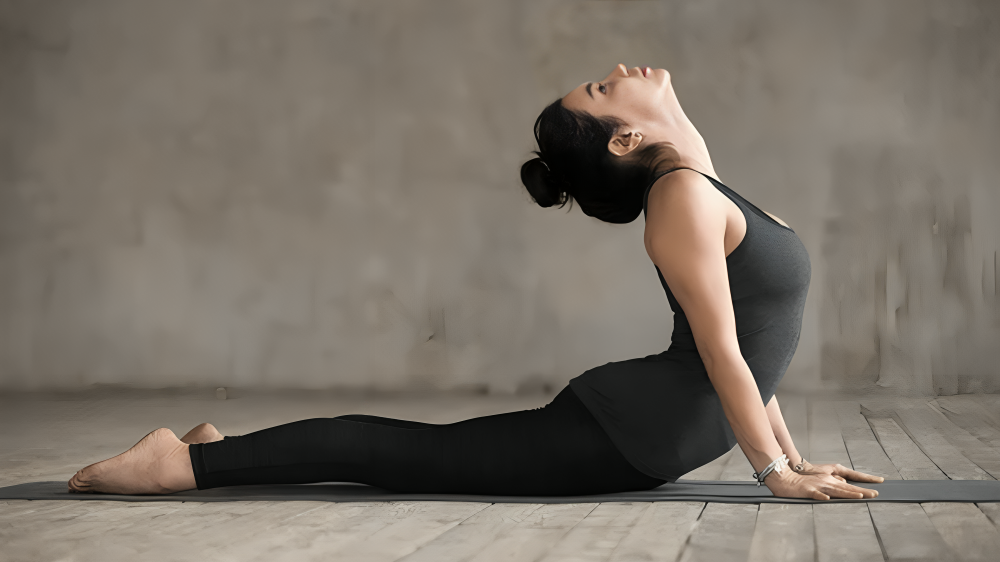
What is Bhujangasana?
Bhujangasana, derived from the Sanskrit words “Bhujanga” (meaning snake) and “Asana” (meaning posture), mimics the graceful posture of a cobra with its hood raised. It’s a fundamental back-bending pose in yoga that targets the spine, chest, and abdomen, helping to build strength and flexibility.
How to Do Bhujangasana (Cobra Pose)
Step-by-Step Instructions:
Start by lying face down on your yoga mat with your legs extended back, tops of your feet resting on the mat. Keep your feet close together, and let your heels slightly touch each other.
Place your hands under your shoulders, palms down, with your fingers pointing forward. Your elbows should be close to your body.
Inhale deeply and gently press your palms into the mat. As you do so, slowly lift your chest off the ground. Use the strength of your back muscles rather than pushing with your hands.
Raise your upper body while keeping your lower ribs on the floor. Your elbows should remain slightly bent and close to your sides. Do not strain your neck; keep it neutral, and gaze forward or slightly upward.
Hold the pose for 15 to 30 seconds while breathing normally. Feel the stretch in your spine, chest, and shoulders.
Exhale and slowly lower your chest back down to the mat. Rest your head to one side and relax your body.
Repeat the pose two to three times, gradually increasing the duration as you become more comfortable with the posture.
Benefits of Bhujangasana
Strengthens the Spine
The Cobra Pose helps to increase the flexibility and strength of the spine. Regular practice can alleviate back pain and prevent spinal issues.
Opens Up the Chest and Shoulders
This pose stretches the chest muscles, improving lung capacity and respiratory function. It’s especially beneficial for those who suffer from asthma or other respiratory conditions.
Stimulates Abdominal Organs
By gently massaging the abdominal organs, Bhujangasana promotes better digestion and helps alleviate constipation.
Improves Posture
Practicing this pose can correct postural imbalances caused by prolonged sitting or poor posture habits. It helps to open up the shoulders and chest, counteracting the effects of slouching.
Relieves Stress and Fatigue
The pose stimulates the adrenal glands, which release hormones that help reduce stress and anxiety. The deep breathing associated with this pose also promotes relaxation and calms the mind.
Enhances Circulation
By stretching the chest and spine, Bhujangasana improves blood circulation throughout the body, which can help reduce the risk of cardiovascular diseases.
Boosts Energy Levels
The backbend invigorates the body by stimulating the energy centers, making you feel more energized and refreshed.
It’s here Setu Bandhasana how to do it and what are the Benefits
FAQs
1. Can beginners do Bhujangasana?
Yes, Bhujangasana is suitable for beginners, especially with modifications such as using yoga blocks for support.
2. How often should I practice Bhujangasana?
Practicing Bhujangasana 3-4 times a week is a good start, but you can do it daily as part of your yoga routine.
3. What should I do if I feel pain while doing Bhujangasana?
If you experience pain, especially in your lower back or wrists, ease out of the pose and try again with a gentler lift. Consult a yoga instructor if the pain persists.
4. Is Bhujangasana good for back pain?
Yes, when done correctly, Bhujangasana can help alleviate back pain by strengthening the spine and stretching the muscles around it.
5. Can Bhujangasana help with respiratory issues?
Absolutely! By opening up the chest and improving lung capacity, Bhujangasana can be beneficial for those with respiratory problems.

